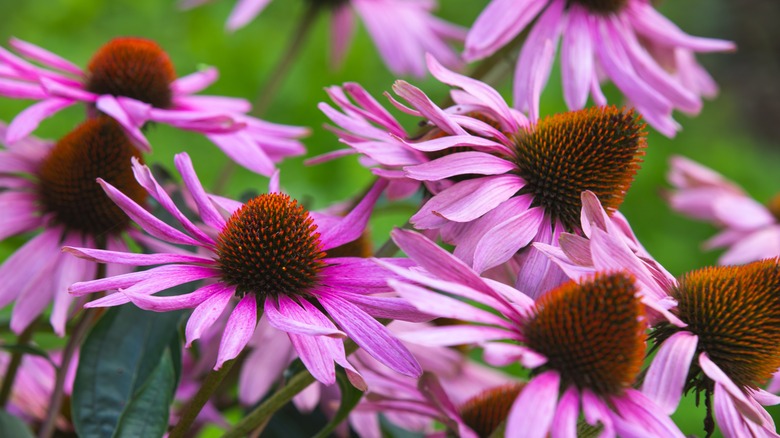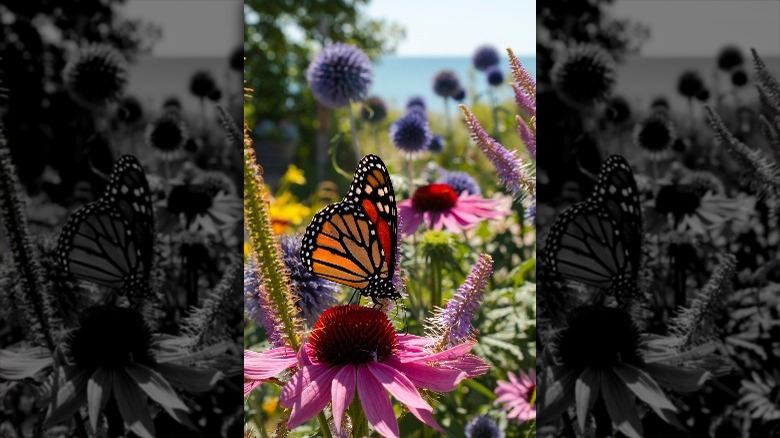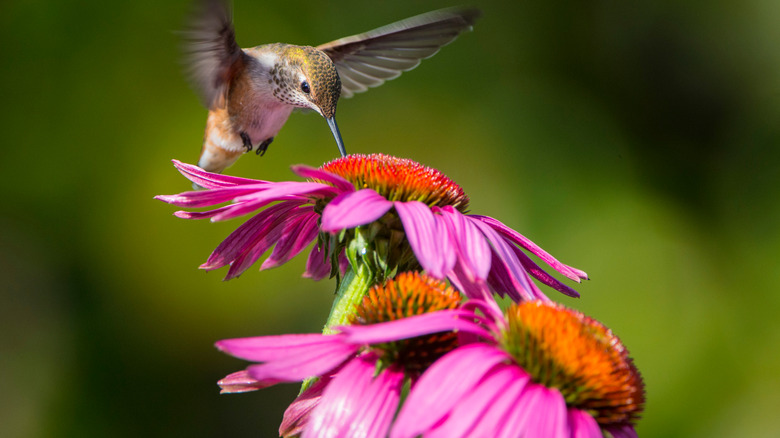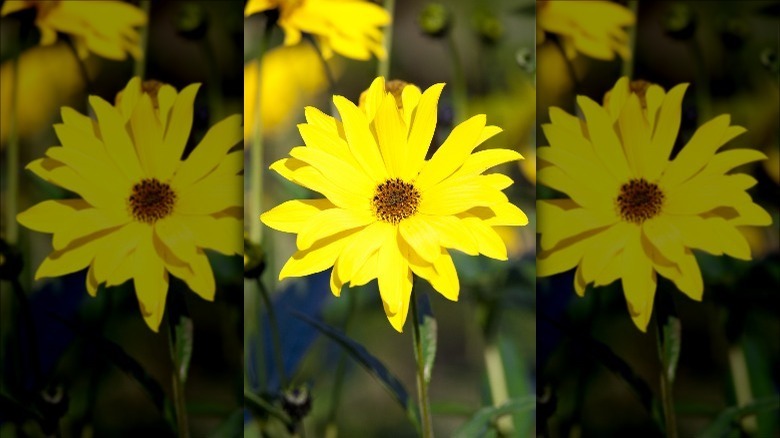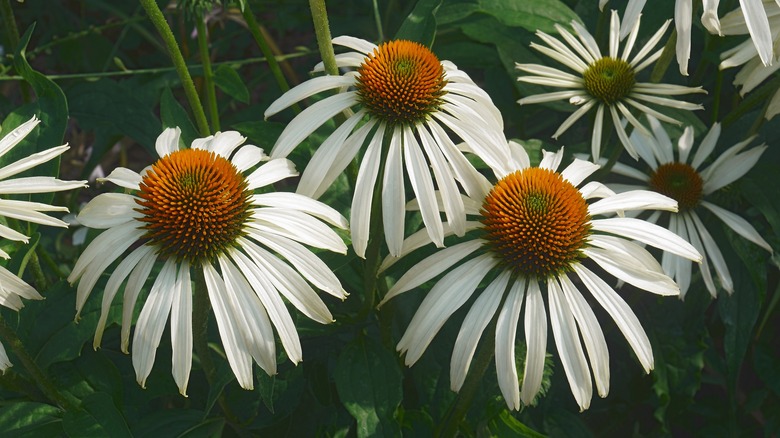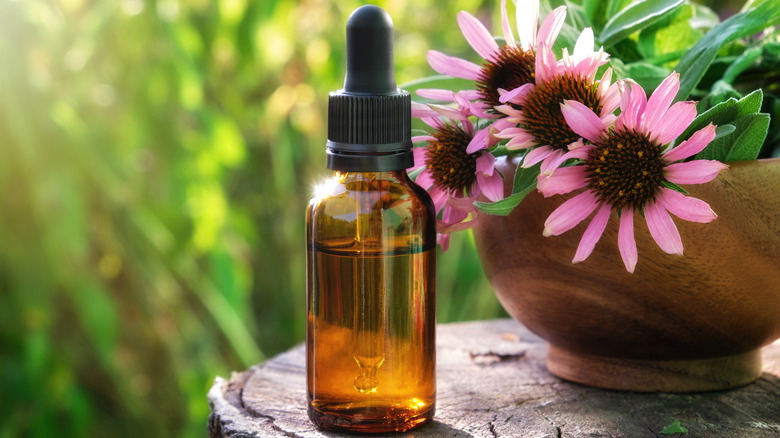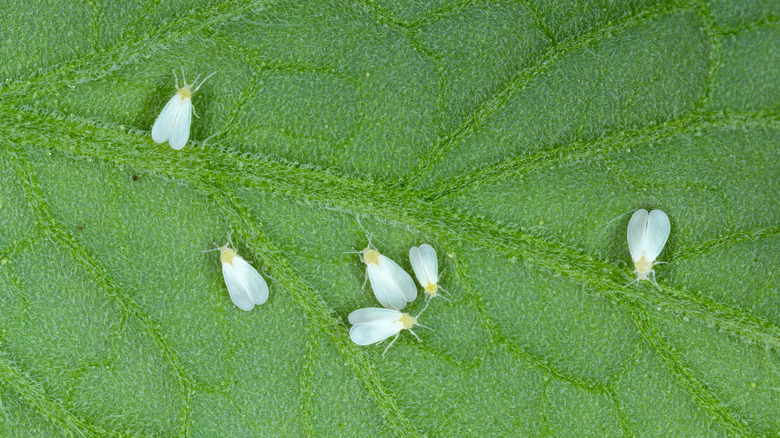How To Grow And Care For Coneflowers
With their fabulous purple petals, coneflowers are a beautiful and whimsical choice for any garden. As stated by Almanac, coneflowers are known scientifically as echinacea, meaning hedgehog. These blooms have prickly lower steps and raised centers that look like — you guessed it — little cones. Coneflowers are hardy perennials that belong to the daisy family. Vibrant and attractive, these flowers are an ideal focal point for your yard. They are native in the eastern and central portions of the United States, stretching from southern Colorado to the Great Lakes. Fortunately, even if you don't live in those regions of the nation, you can still successfully grow these hardy, upright flowers in your home garden. They are a treat to have, as they attract butterflies and birds while also resisting deer.
Coneflowers look best planted en masse, and it's simple to plant a colorful miniature flower field in your backyard. However, if you choose to plant only a small amount, it will still serve as a stunning accent piece to any garden.
How to use coneflowers in garden
There are several reasons why you should consider including echinacea flowers in your garden. First, they are incredibly bold and quite lovely. Coneflowers stand proud and tall, with blooms that span 4 to 6 inches across. While purple is the most commonly seen hue, they come in many other colors including yellow, pale pink, and red-orange. According to Natural Living Ideas, many new varieties of coneflower colors and forms have been developed and are available for home garden planting. Today, you can even sometimes find pure white and very light green coneflowers.
Thanks to their long blooming season, coneflowers attract a wide variety of pollinators with their generous florets. If you're looking to bring more bees, butterflies, and other winged critters into your yard, this hardy flower is an excellent choice. Goldfinches also love coneflower seeds and will frequent these flowers even after they have dried up for winter.
How to grow coneflowers
According to Garden Gate, coneflowers are sun-loving plants that grow well in fully lit areas with well-draining soil. Coneflowers are easy to grow because they are tolerant of weak soil conditions. However, like most other flowers and plants, they bloom best and brightest in soil that's rich in nutrients. To plant coneflowers, loosen soil to a depth of 12 to 15 inches and mix 2 to 4 inches of compost. Pick a spot in your garden that lacks shade so the soil will absorb well and not stay wet. Coneflowers will grow, thrive, and spread in warm, semi-dry areas.
While coneflower seeds are available, they are more commonly purchased as small plants about to bloom. It is best to plant these flowers in the spring, early summer, or fall. Avoid the heat of the season. If you opt for seeds, you can start them indoors 8 to 10 weeks before the last frost of spring. Coneflowers love to embrace their wild side — the less you cut them back, the better they will grow.
How to care for coneflowers
If you have started your coneflowers indoors, transplant them outside once they reach 2 inches in height. Coneflowers are rapid growers, and this won't take too long. Once outside, there are a few things you can do to keep them happy and thriving.
First, make sure they have enough space. Martha Stewart says if you're planting in containers, choose one that is over 24 inches in size; coneflowers like room to stretch out. If you have garden beds or a wide open plot, that is even better. Next, add some fertilizer every spring. Top dressing the soil with a generous 2 inches of compost can really help them thrive. They will bloom stronger every summer, and truly light up your garden. If you don't have the time or energy to deal with composting, a store-bought fertilizer can get the job done too.
Coneflowers are an ideal flower for both novice and advanced green thumbs, with their stunning blooming pattern and low-drama maintenance.
Varieties of coneflowers
While the most commonly seen (and easily purchased) coneflower is purple or yellow with large petals tilted downward, there are many other varieties of coneflowers. According to Gardener's Path, the echinacea boasts a huge range of heights, bloom type, and selections that thrive in both containers and in the ground. These varieties include:
- Butterfly Kisses — this variation has a mature height of 16 to 18 inches and a spread of up to 16 inches. They are ideal for small space gardens and do just fine living their entire life in a flower pot.
- Doubledecker — the Doubledecker comes in a cheerful rose-colored hue and features two tiers of blossoms.
- Doublescoop — this type features large centers and short petals that often contain multiple colors in a single bloom.
- Green jewel — green flowers are rare, and yet coneflowers do in fact come in this color if you're looking for something unique in your garden.
- Marry Me — this coneflower is sweet in white with yellow centers, closely resembling its daisy cousin.
- Playful Meadow Mama — these petals taper at the end for a unique bloom shape
These are just a few of the echinacea varieties available. If you purchase your seeds or plants online, you will find a variety of over 17 different types.
Are coneflowers toxic?
Not only are coneflowers non-toxic, they have long been recognized as a medicinal herb. With an extensive history of being used to increase immunity and helping with wound healing, Native Americans have utilized it for well over 400 years. WebMD states that past evidence suggests that coneflowers might help treat colds, perhaps even helping your body to create white blood cells. Echinacea also plays a role in fighting infection — it has been used to treat urinary tract infections, ear infections, and helping with the healing of cuts.
While echinacea is suspected to be able to help with these things, it is still important to see a doctor if any health issue continues or seems serious. Additionally, while coneflowers may in fact be medicinal, take caution: Those who take immunosuppressants should not take echinacea supplements, as they have been shown to interfere with certain medications. This includes those with tuberculosis, leukemia, diabetes, HIV/AIDS, and those who have received an organ transplant.
Coneflower pests and diseases
While usually resistant to the majority of garden pests, there are still critters that will affect the life and health of coneflowers. As listed on Gardening Know How, the most common culprits are sweet potato whiteflies, aphids, Japanese beetles, and Eriophyid mites. Whiteflies feed off of the underside of the coneflower leaves, and can leave them yellowed and shredded. Meanwhile, aphids — the most notorious pest of the plant world — will quickly deplete coneflowers of their nutrients. This can overwhelm and kill the plant, so make sure to regularly check your leaves for these tiny but vicious pests. Additionally, in early summer, Japanese beetles come out in groups and will feed on the flower petals. They start at the top of the plant and work their way down, so do a spot check for them starting in early June.
Coneflowers are durable and tough, but they can be afflicted by a few different diseases. These include stem rot, powdery mildew, and aster yellows. First, stem rot occurs due to overwatering. Remember that coneflowers are drought-tolerant and don't need a ton of moisture. Second, powdery mildew occurs due to overly moist conditions. Provide ample air circulation and appropriate spacing to avoid it. Finally, aster yellows can result from both insects and subpar growing conditions. Flowers will distort and even die. If a plant is infected, it needs to be removed and thrown away.
